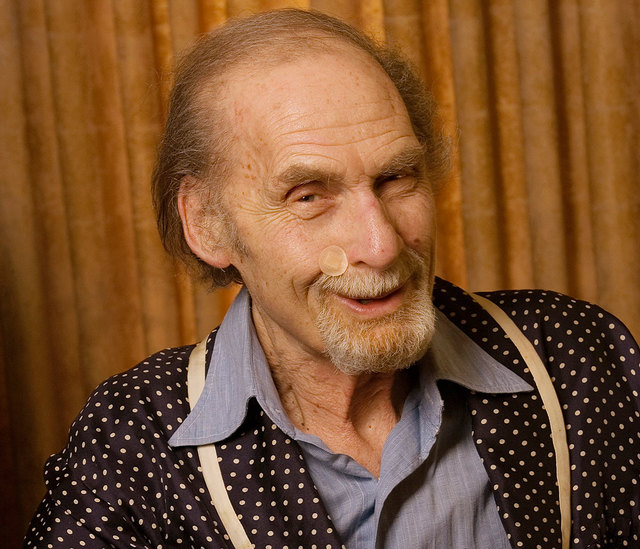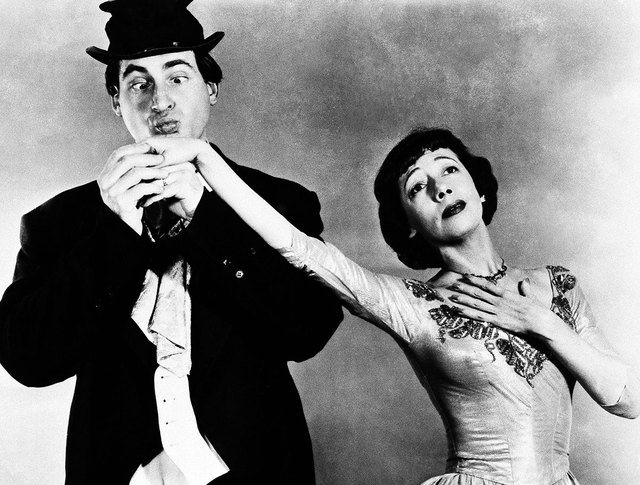Comedian Sid Caesar dies at 91



LOS ANGELES — Sid Caesar, the TV comedy pioneer whose rubber-faced expressions and mimicry built on the work of his dazzling team of writers that included Woody Allen and Mel Brooks, died Wednesday. He was 91.
Family spokesman Eddy Friedfeld said Caesar, who also played Coach Calhoun in the 1978 movie “Grease,” died at his home in the Los Angeles area after a brief illness.
“He had not been well for a while. He was getting weak,” said Friedfeld, who lives in New York and last spoke to Caesar about 10 days ago.
Friedfeld, a friend of Caesar’s who wrote the 2003 biography “Caesar’s Hour,” learned of his death in an early morning call from Caesar’s daughter, Karen.
In his two most important shows, “Your Show of Shows,” 1950-54, and “Caesar’s Hour,” 1954-57, Caesar displayed remarkable skill in pantomime, satire, mimicry, dialect and sketch comedy. And he gathered a stable of young writers who went on to worldwide fame in their own right — including Carl Reiner, Neil Simon, Larry Gelbart (“M-A-S-H’), and Allen.
“He was one of the truly great comedians of my time and one of the finest privileges I’ve had in my entire career was that I was able to work for him,” Allen said in a statement.
Reiner, who was a writer-performer on the breakthrough “Your Show of Shows” sketch program, said he had an ability to “connect with an audience and make them roar with laughter.”
“Sid Caesar set the template for everybody,” Reiner told KNX-AM in Los Angeles. “He was without a doubt, inarguably, the greatest sketch comedian-monologist that television ever produced. He could adlib. He could do anything that was necessary to make an audience laugh.”
The Friars Club called Caesar the “patron saint” of sketch comedy.
“The one great star that television created and who created television was Sid Caesar,” said now-deceased critic Joel Siegel on the TV documentary “Hail Sid Caesar! The Golden Age Of Comedy,” which first aired in 2001.
Friedfeld said Caesar always shared the acclaim.
“Sid was an innovator, he and his team. He was very careful about never taking credit alone. He believed in his co-stars and his writers,” he said. “They created the amazing vehicles for him to be creative.”
While best known for his TV shows, which have been revived on DVD in recent years, he also had success on Broadway and occasional film appearances, notably in “It’s a Mad Mad Mad Mad World.”
Caesar was an occasional Las Vegas performer, including a 1968 reunion with his brilliant collaborator Imogene Coca at the Frontier; the two were co-billed headliners with the subtitle “Together Again” that January.
Twenty years later, Caesar twice returned to the Strip, co-billed with Milton Berle and Danny Thomas as “The Living Legends of Comedy.” They performed at the Riviera and Caesars Palace in the summer of 1988.
Caesar also had a key cameo with Chevy Chase in the hit 1997 movie comedy “Vegas Vacation.”
If the typical funnyman was tubby or short and scrawny, Caesar was tall and powerful, with a clown’s loose limbs and rubbery face, and a trademark mole on his left cheek.
But Caesar never went in for clowning or jokes. He wasn’t interested. He insisted that the laughs come from the everyday.
“Real life is the true comedy,” he said in a 2001 interview with The Associated Press. “Then everybody knows what you’re talking about.” Caesar brought observational comedy to TV before the term, or such latter-day practitioners as Jerry Seinfeld, were even born.
In one celebrated routine, Caesar impersonated a gumball machine; in another, a baby; in another, a ludicrously overemotional guest on a parody of “This Is Your Life.”
He played an unsuspecting moviegoer getting caught between feuding lovers in a theater. He dined at a health food restaurant, where the first course was the bouquet in the vase on the table. He was interviewed as an avant-garde jazz musician who seemed happily high on something.
The son of Jewish immigrants, Caesar was a wizard at spouting melting-pot gibberish that parodied German, Russian, French and other languages. His Professor was the epitome of goofy Germanic scholarship.
Some compared him to Charlie Chaplin for his success at combining humor with touches of pathos.
“As wild an idea as you get, it won’t go over unless it has a believable basis to start off with,” he told The Associated Press in 1955. “The viewers have to see you basically as a person first, and after that you can go on into left field.”
Caesar performed with such talents as Howard Morris and Nanette Fabray, but his most celebrated collaborator Coca, his “Your Show of Shows” co-star.
Coca and Caesar performed skits that satirized the everyday — marital spats, inane advertising, strangers meeting and speaking in clichés, a parody of the Western “Shane” in which the hero was “Strange.” They staged a water-logged spoof of the love scene in “From Here to Eternity.” ”The Hickenloopers” husband-and-wife skits became a staple.
“The chemistry was perfect, that’s all,” Coca, who died in 2001, once said. “We never went out together; we never see each other socially. But for years we worked together from 10 in the morning to 6 or 7 at night every day of the week. What made it work is that we found the same things funny.
In 1988, Caesar told the Review-Journal that “the live factor” was an important dimension missing from modern television.
“When it was live, the audience was part of the show,” he said. “They knew that if you made a mistake, or if a piece of scenery didn’t go or if a sound effect didn’t happen or if somebody forgot their line… they were rooting for you, they were a part of it. Today they’re observers, they’re not part of it. They’re not part of the show.”
Caesar worked closely with his writing staff as they found inspiration in silent movies, foreign films and the absurdities of ’50s postwar prosperity.
Others who wrote for Caesar: Larry Gelbart, Simon and his brother Danny Simon, and Allen, who was providing gags to Caesar and other entertainers while still in his teens.
Carl Reiner, who wrote in addition to performing on the show, based his “Dick Van Dyke Show” — with its fictional TV writers and their temperamental star — on his experiences there. Simon’s 1993 “Laughter on the 23rd Floor” and the 1982 movie “My Favorite Year” also were based on the Caesar show.
A 1996 roundtable discussion among Caesar and his writers was turned into a public television special. Said Simon, the Pulitzer Prize-winning playwright: “None of us who’ve gone on to do other things could have done them without going through this show.”
“This was playing for the Yankees; this was playing in Duke Ellington’s band,” said Gelbart, the creator of TV’s “M-A-S-H” and screenwriter of “Tootsie,” who died in 2009.
Increasing ratings competition from Lawrence Welk’s variety show put “Caesar’s Hour” off the air in 1957.
In 1962, Caesar starred on Broadway in the musical “Little Me,” written by Simon, and was nominated for a Tony. He played seven different roles, from a comically perfect young man to a tyrannical movie director to a prince of an impoverished European kingdom.
“The fact that, night after night, they are also excruciatingly funny is a tribute to the astonishing talents of their portrayer,” Newsweek magazine wrote. “In comedy, Caesar is still the best there is.”
His and Coca’s classic TV work captured a new audience with the 1973 theatrical compilation film “Ten From Your Show of Shows.”
He was one of the galaxy of stars who raced to find buried treasure in the 1963 comic epic “It’s a Mad Mad Mad Mad World,” and in 1976 he put his pantomime skills to work in Brooks’ “Silent Movie.”
But he later looked back on those years as painful ones. He said he beat a severe, decades-long barbiturate and alcohol habit in 1978, when he was so low he considered suicide. “I had to come to terms with myself. ‘Yes or no? Do you want to live or die?’” Deciding that he wanted to live, he recalled, was “the first step on a long journey.”
Caesar was born in 1922 in Yonkers, N.Y., the third son of an Austrian-born restaurant owner and his Russian-born wife. His first dream was to become a musician, and he played saxophone in bands in his teens.
But as a youngster waiting tables at his father’s luncheonette, he liked to observe as well as serve the diverse clientele, and recognize the humor happening before his eyes.
His talent for comedy was discovered when he was serving in the Coast Guard during World War II and got a part in a Coast Guard musical, “Tars and Spars.” He also appeared in the movie version. Wrote famed columnist Hedda Hopper: “I hear the picture’s good, with Sid Caesar a four-way threat. He writes, sings, dances and makes with the comedy.”
That led to a few other film roles, nightclub engagements, and then his breakthrough hit, a 1948 Broadway revue called “Make Mine Manhattan.”
His first TV comedy-variety show, “The Admiral Broadway Revue,” premiered in February 1949. But it was off the air by June. Its fatal shortcoming: unimagined popularity. It was selling more Admiral television sets than the company could make, and Admiral, its exclusive sponsor, pulled out.
But everyone was ready for Caesar’s subsequent efforts. “Your Show of Shows,” which debuted in February 1950, and “Caesar’s Hour” three years later reached as many as 60 million viewers weekly and earned its star $1 million annually at a time when $5, he later noted, bought a steak dinner for two.
When “Caesar’s Hour” left the air in 1957, Caesar was only 34. But the unforgiving cycle of weekly television had taken a toll: His reliance on booze and pills for sleep every night so he could wake up and create more comedy.
It took decades for him to hit bottom. In 1977, he was onstage in Regina, Canada, doing Simon’s “The Last of the Red Hot Lovers” when, suddenly, his mind went blank. He walked off stage, checked into a hospital and went cold turkey. Recovery had begun, with the help of wife Florence Caesar, who would be by his side for more than 60 years and helped him weather his demons.
Those demons included remorse about the flared-out superstardom of his youth — and how the pressures nearly killed him. But over time he learned to view his life philosophically.
“You think just because something good happens, THEN something bad has got to happen? Not necessarily,” he said with a smile in 2003, pleased to share his hard-won wisdom: “Two good things have happened in a row.”
———
For the Review-Journal, Mike Weatherford contributed to this report. Associated Press writers Frazier Moore in New York and Christopher Weber and Jessica Herndon in Los Angeles contributed to this report.












